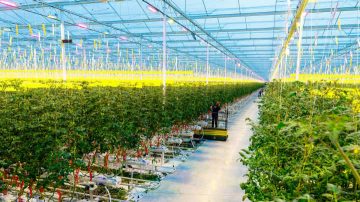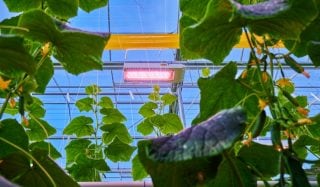Be the first! Get the latest news and updates - Subscribe to our newsletter!
LED dimming can reduce your energy costs
- With Signify dimming technology and the Philips GrowWise Control System you have a powerful new way to manage your crop growth and energy prices.
- It is now possible to integrate the GrowWise Control System with your climate control system to easily manage uniform growth through LED dimming.
Eindhoven, the Netherlands – Customers in retail markets expect a year-round supply of quality produce and flowers at market prices. But for you as a grower, fluctuating and increasing energy prices do not make life easier. Especially when it comes to light, you need to ensure the uniformity that’s most beneficial for your plants whatever the price might be at a given moment on a given day.
Fortunately, I have good news for growers using Philips GreenPower LED lighting. You have a powerful new way to manage your crop growth and energy prices thanks to Signify’s dimming technology. You can now integrate our Philips GrowWise Control System into your climate control systems to dim your Philips GreenPower LED grow lights.
How to get more from your climate control?
Artificial light is a key determinant for the success of your crops. With the current climate control technology, there are more sensors than ever in your greenhouse. These give you more insights on a micro level, and the opportunity to steer your crop growth more precisely. So, for growth precision, it makes sense to adjust your light levels based on the increased insights provided by the sensors.
But there is another equally important reason to manage your light levels as precisely as possible.
Artificial light is one of the most energy-consuming elements in your greenhouse. With today’s high energy prices, growers are looking for ways to reduce costs without compromising quality.
So how can you get more out of your climate control investment? On the one hand, how can you achieve the optimum DLI (Daily Light Integral), the volume of light that is photosynthetically active, while on the other hand minimizing the energy costs of your light installation?
Uniform, reliable dimming with the GrowWise Control System

With the Philips GrowWise Control System from Signify, you can dim your lights reliably and easily via your climate control system. The GrowWise Control System can be connected to your climate computer to manage settings through one application, place, and system. So, there is no need to switch to other programs. You can adjust the light level of your LEDs as easily as you adjust the temperature, screens, and irrigation.
The GrowWise Control System lets you adjust the light intensity to the exact needs of your crop. When integrated with your climate computer, you can link to a daylight sensor and steer the DLI for your plants in a fully integrated way. You have full control over dimming and the amount of light, and insights and improvements here can make a big difference in your bottom line. You can address fluctuating energy prices by dimming your lights when prices are high and setting the lights to 100% when prices are down. You light your crop in a uniform way, manage your DLI and sell the produced electricity from your CHP back to the grid at the time of your choice.
Patented Coded Mains technology for uniform crop growth
The brains behind all this is the patented Philips Coded Mains technology. This robust system transmits a signal to each of the grow lights in your greenhouse to dim to the same light intensity. The signal is sent via the power cable and transports a command on the waves of the voltage. This eliminates the need for additional control cables that add costs and hassle during the system installation. The lights have an integrated sensor that reads the signal or command and reacts to your requested dim setting.
Why does the Coded Mains technology use a power cable for signal transport? The alternative is a wireless control using technology such as WIFI or Bluetooth. But there are many things in your greenhouse that can block or interfere with the wireless signal, such as: plants, water from irrigation and steel from the construction. This could cause different levels of dimming for different grow lights throughout the greenhouse, resulting in non-uniform crop growth or unexpected surprises in your energy usage. That is why, at this time, we have chosen for the solution via Coded Mains, as all the grow lights in the system need to receive the same, strong signal in order to function properly. The robustness of the Coded Mains system gives you peace of mind knowing that all lights in your greenhouse are dimmed to the same level and your crop is growing in a uniform way. That’s why Signify engineers decided to use a wired signal that is more robust in your greenhouse environment.
Dimming is better than turning off some lights
Modern growers can adjust their climate settings with great precision to achieve high yields, good quality products and produce sustainably with optimum use of resources. This also applies to adjusting artificial light. There are many reasons to adjust the light level in a greenhouse. The plants need less light at certain stages of the crop growth or at certain times of day. Young plants could have a lower tolerance to light than crops ready for harvest. On a summer day, the need for light might be lower than during a winter day.
For many growers, a checkerboard lighting setup is common practice. In this setup, growers simply turn off a number of lights to adjust the light levels. This reduces the amount of light but also negatively affects light uniformity.
That’s why dimming is better. Dimming maintains the right uniformity. And an additional advantage: the lights become even more efficient. When dimming to 50%, the efficacy of a lighting module can increase by 8%, from 3.7 to 4.0 µmol/J (depending on the product type). This not only increases the sustainability of your greenhouse operation. With today’s energy prices the savings can add up quickly and be substantial.
The power of dimming with Signify
With Signify dimming technology and the Philips GrowWise Control System you have a powerful new way to manage your crop growth and energy prices.
LED lights can be dimmed via your climate computer, so you have all your settings in one place. The Coded Mains technology sends a robust signal to the lights via the power cables, so you don’t spend extra money on extra cables. And all fixtures dim to the same level to ensure a uniform light blanket for your crop.
In short, LED lighting provides higher year-round crop growth, higher product quality and improved predictability. That can help your business results to shine a little bit brighter.
Learn more about how our horticultural LED lighting can benefit growers around the world and visit our webpages.

Rene van Wees heads the application engineering team at Signify and is also called the George Clooney of Signify. His team of application engineers ensures growers are provided with high-end horticulture lighting designs. With his background in optics, he trains internal teams and external customers in the radiometry of the horticulture product portfolio. He provides consultancy to customers and engineers to drive continuous improvement of Philips LED lighting solutions.
Related articles
Contact us
Contact certified partners
Philips products are sold through a global network of certified partners. Find partners in your region for more information about Philips LED grow lights.
Contact Philips
What are the best LED grow lights for your situation? We are here to help. Please use our form to submit your request.
Interested?
Learn more about LED lighting in horticulture by reading our latest articles and case studies.




